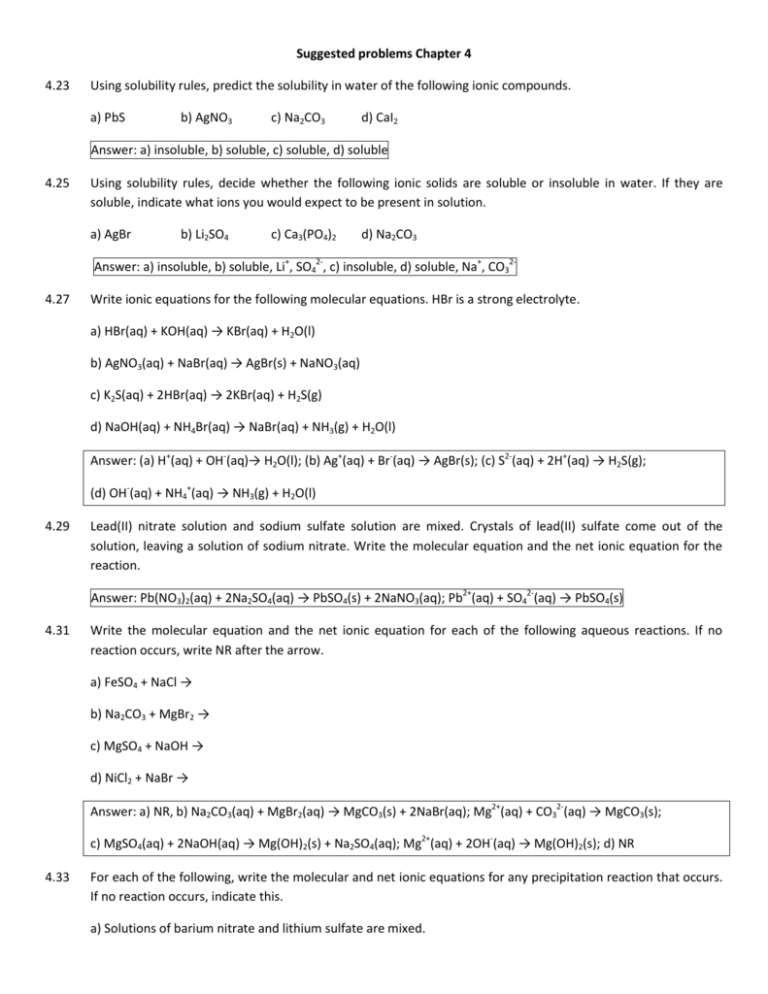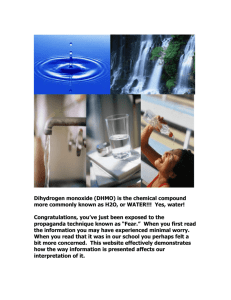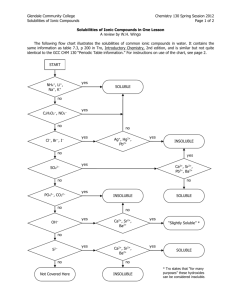Suggested problems Chapter 4 4.23 Using solubility rules, predict
advertisement

Suggested problems Chapter 4 4.23 Using solubility rules, predict the solubility in water of the following ionic compounds. a) PbS b) AgNO3 c) Na2CO3 d) CaI2 Answer: a) insoluble, b) soluble, c) soluble, d) soluble 4.25 Using solubility rules, decide whether the following ionic solids are soluble or insoluble in water. If they are soluble, indicate what ions you would expect to be present in solution. a) AgBr b) Li2SO4 c) Ca3(PO4)2 d) Na2CO3 Answer: a) insoluble, b) soluble, Li+, SO42-, c) insoluble, d) soluble, Na+, CO324.27 Write ionic equations for the following molecular equations. HBr is a strong electrolyte. a) HBr(aq) + KOH(aq) → KBr(aq) + H2O(l) b) AgNO3(aq) + NaBr(aq) → AgBr(s) + NaNO3(aq) c) K2S(aq) + 2HBr(aq) → 2KBr(aq) + H2S(g) d) NaOH(aq) + NH4Br(aq) → NaBr(aq) + NH3(g) + H2O(l) Answer: (a) H+(aq) + OH-(aq)→ H2O(l); (b) Ag+(aq) + Br-(aq) → AgBr(s); (c) S2-(aq) + 2H+(aq) → H2S(g); (d) OH-(aq) + NH4+(aq) → NH3(g) + H2O(l) 4.29 Lead(II) nitrate solution and sodium sulfate solution are mixed. Crystals of lead(II) sulfate come out of the solution, leaving a solution of sodium nitrate. Write the molecular equation and the net ionic equation for the reaction. Answer: Pb(NO3)2(aq) + 2Na2SO4(aq) → PbSO4(s) + 2NaNO3(aq); Pb2+(aq) + SO42-(aq) → PbSO4(s) 4.31 Write the molecular equation and the net ionic equation for each of the following aqueous reactions. If no reaction occurs, write NR after the arrow. a) FeSO4 + NaCl → b) Na2CO3 + MgBr2 → c) MgSO4 + NaOH → d) NiCl2 + NaBr → Answer: a) NR, b) Na2CO3(aq) + MgBr2(aq) → MgCO3(s) + 2NaBr(aq); Mg2+(aq) + CO32-(aq) → MgCO3(s); c) MgSO4(aq) + 2NaOH(aq) → Mg(OH)2(s) + Na2SO4(aq); Mg2+(aq) + 2OH-(aq) → Mg(OH)2(s); d) NR 4.33 For each of the following, write the molecular and net ionic equations for any precipitation reaction that occurs. If no reaction occurs, indicate this. a) Solutions of barium nitrate and lithium sulfate are mixed. b) Solutions of sodium bromide and calcium nitrate are mixed c) Solutions of aluminum sulfate and sodium hydroxide are mixed. d) Solutions of calcium bromide and sodium phosphate are mixed. Answer: a) Ba(NO3)2(aq) + Li2SO4(aq) → BaSO4(s) + LiNO3(aq); Ba2+(aq) + SO42-(aq) → BaSO4(s); b) NR; c) Al2(SO4)3(aq) + 6NaOH(aq) → 2Al(OH)3(s) + 3Na2SO4(aq); Al3+(aq) + 3OH-(aq) → Al(OH)3(s); d) 3CaBr2(aq) + 2Na3PO4(aq) → Ca3(PO4)2(s) + 6NaBr(aq); 3Ca2+(aq) + 2PO42-(aq) → Ca3(PO4)2(s) 4.35 Classify each of the following as a strong or weak acid or base. a) HF b) KOH c) HClO4 d) HIO Answer: a) weak acid; b) strong base; c) strong acid; d) strong acid 4.37 Complete and balance each of the following molecular equations (in aqueous solution); include phase labels. Then, for each, write the net ionic equation. a) NaOH + HNO3 → b) HCl + Ba(OH)2 → c) HC2H3O2 + Ca(OH)2 → d) NH3 + HNO3 → Answer: a) NaOH(aq) + HNO3(aq) → NaNO3(aq) + H2O(l); H+(aq) + OH-(aq) → H2O(l); b) 2HCl(aq) + Ba(OH)2(aq) → BaCl2(aq) + 2H2O(l); H+(aq) + OH-(aq) → H2O(l); c) 2HC2H3O2(aq) + Ca(OH)2(aq) → Ca(C2H3O2)2(aq) + 2H2O(l); HC2H3O2(aq) + OH-(aq) → C2H3O2-(aq) + H2O(l); d) NH3(aq) + HNO3(aq) → NH4NO3(aq); H+(aq) + NH3(aq) → NH4+(aq) 4.43 Write molecular and net ionic equations for the successive neutralizations of each acid hydrogen of sulfurous acid by aqueous calcium hydroxide. CaSO3 is insoluble; the acid salt is soluble. Answer: 2H2SO3(aq) + Ca(OH)2(aq) → Ca(HSO3)2(aq) + 2H2O(l); Ca(HSO3)2(aq) + Ca(OH)2(aq) → 2Ca(SO3)2(s) + 2H2O(l); H2SO3(aq) + OH-(aq) → HSO3-(aq) + H2O(l); Ca2+(aq) + HSO3-(aq) + OH-(aq) → CaSO3(s) + H2O(l) 4.47 Write the molecular equation and the net ionic equation for the reaction of solid iron(II) sulfide and hydrochloric acid. Add phase labels. Answer: FeS(s) + 2HCl(aq) → H2S(g) + FeCl2(aq); FeS(s) + 2H+(aq) → Fe2+(aq) + H2S(g) 4.49 Obtain the oxidation number for the elements noted in each of the following. a) Ga in Ga2O3 b) Nb in NbO2 c) Br in KBrO4 d) Mn in K2MnO4 Answer: a) +3, b) +4, c) +7, d) +6 4.51 Obtain the oxidation number for the elements noted in each of the following. a) N in NH2- b) I in IO3- c) Al in Al(OH)4- d) Cl in HClO4 Answer: a) -3, b) +5, c) +3, d) +7 4.53 Determine the oxidation numbers of all the elements in each of the following compounds. (Hint: Look at the ions present). a) Mn(ClO3)2 b) Fe2(CrO4)3 c) HgCr2O7 d) Co3(PO4)2 Answer: a) Mn: +2, Cl: +5, O: -2; b) Fe: +3, Cr: +6, O: -2; c) Hg: +2, Cr: +6, O: -2; d) Co: +2, P: +5, O: -2 4.55 In the following reactions, label the oxidizing agent and the reducing agent. a) P4(s) + 5O2(g) → P4O10(s) b) Co(s) + Cl2(g) → CoCl2(s) Answer: a) P4(s): reducing agent, O2(g): oxidizing agent; b) Co(s): reducing agent, Cl2(g): oxidizing agent 4.57 In the following reactions, label the oxidizing agent and the reducing agent. a) 2Al(s) + 3F2(g) → 2AlF3(s) b) Hg2+(aq) + NO2-(aq) + H2O(l) → Hg(s) + 2H+(aq) + NO3-(aq) Answer: a) Al(s): reducing agent, F2(g): oxidizing agent; b) Hg2+: oxidizing agent, NO2-(aq): reducing agent 4.59 Balance the following oxidation-reduction reactions by the half-reaction method. a) CuCl2(aq) + Al(s) → AlCl3(aq) + Cu(s) b) Cr3+(aq) + Zn(s) → Cr(s) + Zn2+ Answer: a) 3Cu2+(aq) + 2Al(s) → 2Al3+(aq) + 3Cu(s); b) 2Cr3+(aq) + 3Zn(s) → 2Cr(s) + 3Zn2+(aq) 4.61 A sample of 0.0512 mol of iron(III) chloride, FeCl3, was dissolved in water to give 25.0 mL of solution. What is the molarity of the solution? Answer: 2.05 M 4.63 An aqueous solution is made from 0.798 g of potassium permanganate, KMnO4. If the volume of solution is 50.0 mL, what is the molarity of KMnO4 in the solution? Answer: 0.101 M 4.67 An experiment calls for 0.0353 g of potassium hydroxide, KOH. How many milliliters of 0.0176 M KOH are required? Answer: 35.8 mL 4.69 Heme, obtained from red blood cells, binds oxygen, O2. How many moles of heme are there in 150 mL of 0.019 M heme solution? Answer: 2.85 x 10-4 mol 4.71 How many grams of sodium dichromate, Na2Cr2O7, should be added to a 100.0-mL volumetric flask to prepare 0.025 M Na2Cr2O7 when the flask is filled to the mark with water? Answer: 0.66 g 4.73 You wish to prepare 0.12 M HNO3 from a stock solution of nitric acid that is 15.8 M. How many milliliters of the stock solution do you require to make up 1.00 L of 0.12 M HNO3? Answer: 7.6 mL 4.75 A 3.50 g sample of KCl is dissolved in 10.0 mL of water. The resulting solution is then added to 60.0 mL of a 0.500 M CaCl2(aq) solution. Assuming that the volumes are additive, calculate the concentrations of each ion present in the final solution. Answer: 0.429 M Ca2+; 0.670 M K+; 1.528 M Cl- 4.77 A chemist added an excess of sodium sulfate to a solution of a soluble barium compound to precipitate all of the barium ion as barium sulfate, BaSO4. How many grams of barium ion are in a 458-mg sample of the barium compound if a solution of the sample gave 513 mg BaSO4 precipitate? What is the mass percentage of barium in the compound? Answer: 0.302 g; 65.9 % 4.79 Copper has compounds with copper(I) ion or copper(II) ion. A compound of copper and chloride was treated with a solution of silver nitrate, AgNO3, to convert the chloride ion in the compound to a precipitate of AgCl. A 59.40-mg sample of the copper compound gave 86 mg AgCl. a) Calculate the percentage of chlorine in the copper compound. b) Decide whether the formula of the compound is CuCl or CuCl2. Answer: a) 35.81 %, b) CuCl 4.81 A compound of iron and chloride is soluble in water. An excess of silver nitrate was added to precipitate the chloride ion as silver chloride. If a 134.8-mg sample of the compound gave 304.8 mg AgCl, what is the formula of the compound? Answer: FeCl2 4.83 What volume of 0.250 M HNO3 (nitric acid) reacts with 44.8 mL of 0.150 M Na2CO3 (sodium carbonate) in the following reaction? 2HNO3(aq) + Na2CO3(aq) → 2NaNO3(aq) + H2O(l) + CO2(g) Answer: 53.8 mL 4.85 How many milliliters of 0.150 M H2SO4 (sulfuric acid) are required to react with 8.20 g of sodium hydrogen carbonate, NaHCO3, according to the following reaction? H2SO4(aq) + NaHCO3(aq) → Na2SO4(aq) + 2H2O(l) + 2CO2(g) Answer: 325 mL 4.87 A solution of hydrogen peroxide, H2O2, is titrated with a solution of potassium permanganate, KMnO4. The reaction is 5H2O2(aq) + 2KMnO4(aq) + 3H2SO4(aq) → 5O2(g) + 2MnSO4(aq) + K2SO4(aq) + 8H2O(l) It requires 51.7 mL of 0.145 KMnO4 to titrate 20.0 g of the solution of hydrogen peroxide. What is the mass percentage of H2O2 in the solution? Answer: 3.19% 4.91 Niquel(II) sulfate reacts with lithium hydroxide solution to produce a precipitate of niquel(II) hydroxide and a solution of lithium sulfate. Write the molecular equation for this reaction. Then write the corresponding ionic equation. Answer: NiSO4(aq) + 2LiOH(aq) → Ni(OH)2(s) + Li2SO4(aq); Ni2+(aq) + 2OH-(aq) → Ni(OH)2(s)





